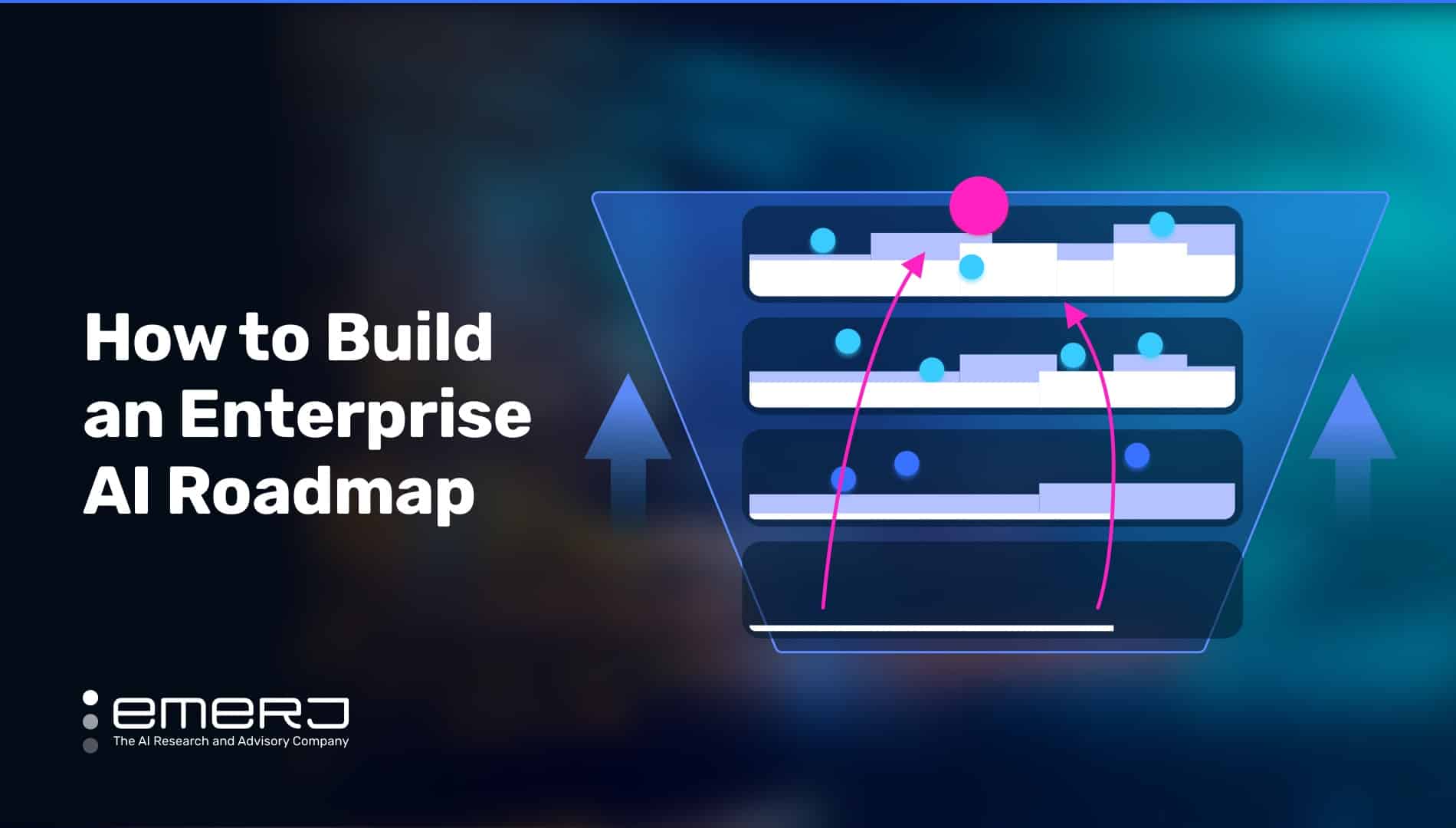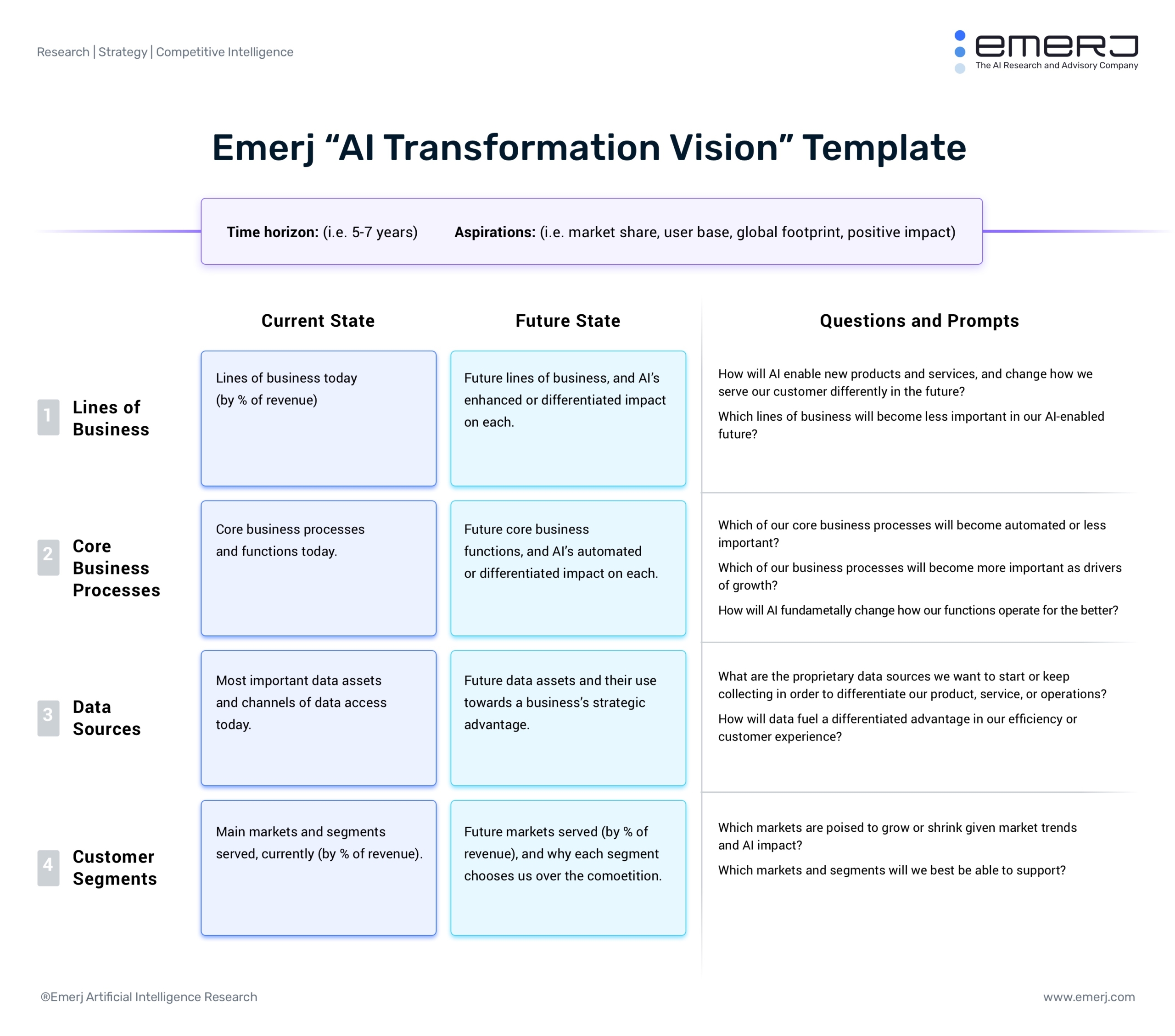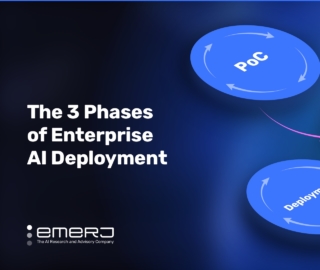
The firms that will gain a genuine advantage from AI deploy the technology in a way that achieves short-term ROI, alignment to a long-term vision, and conscious development of AI maturity – including skills, data infrastructure, and more.
Emerj’s Phasic AI Roadmap model (below) allows executives to consider these three success elements clearly while thinking through their early AI projects.
In this article, we’ll explore the components and benefits of the Phasic AI Roadmap model, and walk through a four-step process of putting it into action.

While some of the details of the roadmap-building exercises might different depending on the AI maturity or size of the firm, the same four steps usually apply. In the sub-sections below, we’ll walk through how AI project leaders can walk through each of the four steps – along with the team members required to execute each step.
By following the simple process below, any AI project leader should be able to develop a strong first draft of a Phasic AI Roadmap, and use this draft as a tool to align stakeholders (especially leadership), and to select and filter for near-term AI projects in line with their transformation vision.
Step 1 – Begin with the End in Mind

Before mapping out AI projects and short-term initiatives, determine the strategic goals that leadership is striving towards – and how AI might enhance, accelerate, or augment existing strategic goals.
In a previous best practice guide we covered the varieties of “strategic anchors” the might be used to attach AI to higher-level outcomes beyond near-term band-aid applications of AI. These anchors might include:
- 3-5 year goals
- Key differentiators (at a company or product level)
- Current initiatives or thrusts
Ideally, this exercise is paired with an AI Transformation Vision exercise to find the AI or data-backed capabilities most likely to help the firm succeed in the marketplace in the long term.
While any new AI project must be held to firm standards of near-term ROI, leadership must understand that AI is an investment in a new paradigm of skills and resources, and that while not all experiments will prove immediately valuable in financial terms, initiatives that build towards core strengths and skills are ultimately valuable to creating transformation, not just surface-level solutions (see our longer article on this topic: Setting the Right AI Expectations).
Team members and roles involved in this step:
- Business leadership (preferably C-level) – Lists strategic anchors and provides context on the current vision for the future of the company.
- Subject-matter experts – Provides context on specific business processes, workflows, and operations involved in the long-term strategic vision.
- AI project or initiative leader(s) – Facilitates communication between groups, collates insights into a coherent document that other stakeholders can understand.
Step 2 – The AI Opportunity Discovery Process
AI opportunity discovery can be achieved through many means, and there are many approaches to building a “laundry list” of possible AI initiatives. Below, we provide two such approaches to AI opportunity discovery, along with expert interviews that provide more context on the respective approaches.
Approach 1: Beginning with Workflows
- List out business processes, includes:
- Critical processes, examples:
- For ecommerce firms, this might be logistics, inventory management, marketing
- For a bank, this might involve fraud process, or underwriting, or compliance
- Repetitive, time-consuming processes
- Anything that doesn’t require much cognition, but occupies large amounts of time for existing staff
- Any monotonous part of the workflow that annoys staff and slows down the overall process
- For business processes, remember to break the processes down into the points where AI can fit in, specific decisions that need to be made, like:
- Should I approve this mortgage application?
- At what price should I list this product for this user?
- When should I send out this email promotion to this user?
- Should I shut down this machine? (because it might be malfunctioning)
- Critical processes, examples:
- Then, list out the data that might be used to solve that problem. Brainstorm potential data sources to solve this problem, and sort them by factors relevant to the project team, such as:
- Accessibility
- Legal risk
- Data formatting or cleanliness
- Etc
- Once an array of potential problem and data matches are made, investigate the viability of the data sources to the business use-cases by looking into the quality and accessibility of the key data sources you’ve discovered.
For a useful walkthrough about finding early, accessible AI opportunities, listen to our interview with Vlad Sejnoha of Glasswing Ventures on The AI in Business Podcast:
Approach 2: Beginning with Data
- List the core data stores of the business related to the business functions that you’re investigating. It’s nearly impossible to list all possible sources or types of data in a business, but the project becomes reasonable when it is limited to specific domains related to departments (customer service, marketing, legal, etc), or broad themes or goals (such as “increasing manufacturing throughput,” or “improving retail loyalty and cart value,” etc…).
- Back the data into its potential relevance for business processes, by determining a hypothesized business case for how that data could add value to a workflow. For example:
- How might logistics and shipping data help with inventory management?
- How might our unique data set about time series data help us encourage retention and continued use by our customers?
- How might the features and factors in our fraud data help us detect fraud preemptively?
- Have data scientists and SMEs vet business cases and create a final list of formal succinct use-case ideas, which include how and where the data, algorithms, and workflows might work together to add value to or automate a business process.
Adam Bonnifield, VP of Artificial Intelligence at Airbus, breaks down his approach to beginning with data in this popular episode of The AI in Business Podcast:
Regardless of your specific approach, the aim is to end up with a list of AI opportunities that:
-
- Handle/address near-term pressing issues, especially if leadership initially brought you in for a near-term issue.
- Will build towards important next phases of maturity.
- Align to strategic value.
- Align to an AI transformation vision (or, as much of one as we have).
Aim to develop a “portfolio mindset” to reaching near-term goals (i.e. “here are three ways we could use customer service data to improve UX”). Have multiple pathways towards strategic ends – frame AI initiatives as experiments, not as definitely, sure-fire stepping stones. Embracing this mentality is key to wielding AI successfully, and budgeting for AI projects realistically.
Team members and roles involved in this step:
- AI project or initiative leader(s) – Facilitate discovery sessions and pull in relevant stakeholder and expertise groups for the discovery process.
- Subject-matter experts – Provide context on possible AI use-case opportunities within specific business functions, or general inefficiencies/challenges/opportunities in specific operational workflows.
- Data scientists – Discern the viability of potential AI projects, and ask the right questions to determine if AI might be the right tool for the job.
- IT team – To determine the infrastructure needs for specific AI applications, and provide context on how viable or burdensome potential AI projects might be from an IT perspective.
Step 3 – Assess Our Current State of AI Maturity
Once we understand the future state we’d like to achieve, and we have an array of AI opportunities to choose from, we can assess the viability of our AI opportunities via an AI maturity assessment (a topic for another article, but readers may be interested in using our Critical Capabilities model for assessing AI maturity).
We generally advise firms to assess AI maturity after (not before) discovering possible AI opportunities, because:
- Focusing on AI maturity before AI opportunities tends to limit our opportunities discovery process and can prevent the kind of big picture thinking needed to form an AI transformation vision.
- Assessing AI maturity, generally, across an entire enterprise might take months – while focusing on assessing maturity only in those areas where we have viable near-term AI opportunities is much more manageable.
Team members and roles involved in this step:
- AI project or initiative leader(s) – Determine a framework for maturity ranking and measurement, and pool together relevant experts and stakeholder groups.
- Subject-matter experts – Provide context on AI maturity, AI use-cases, or AI fluency in different specific business units or functions.
- Data scientists – Determine the level of AI maturity in different parts of the business (across skills, culture, resources).
- IT team – Assess the level of AI readiness of the enterprises’ departments from an infrastructure and digital transformation standpoint.
Interested in more step-by-step frameworks and AI best practices? Unlock the full AI framework and use-case library with Emerj Plus:
Step 4 – Drafting a Phasic AI Roadmap
By this step, we’ve already long completed a draft-level understanding of our AI transformation vision – or at a minimum – we have a robust understanding of how AI might bolster our most important strategic and long-term company initiatives and goals.
Begin with that end vision, and work from top to bottom in your Phasic AI Roadmap exercise, through Phase 3, Phase 2, and Phase 1 (where your current projects will reside) respectively.
Phase 3 is aspirational – and relates to future AI capabilities that might bolster your strategic position or differentiators. Think about this phase as being core AI-enabled capabilities that would pull your company far ahead of the competition, but might take you 5-7 years to obtain or bring to life.
Phase 2 should be considered not as concrete plans, but as possible, logical extensions between your phase 1 AI applications, and your long-term vision. These are possible use-cases you might try, or “grow into” in the next 1-2 years.
Phase 1 of a Phasic AI Roadmap should serve to develop important areas of fluency and maturity while also delivering near-term value and moving a firm closer to its long-term strategic aims. Firms new to AI might only select one or two potential projects, with backup “portfolio” projects if the first approaches fail to deliver.
A completed phase 1 will include a portfolio of near-term projects, with each potential initiative clearly connected to both:
- Specific elements of AI maturity that this initiative will focus on improving, and
- Direct connections to Phase 2, Phase 3, or the AI Transformation Vision (i.e. clear connection to
Think about AI initiatives as “pulling” the company up into new levels of maturity, and new levels of capability to wield AI and data.
- AI project or initiative leader(s) – To pull together relevant stakeholder groups, collect ideas and mandates, iterate early drafts, and compose a first version of the roadmap itself.
- Business leadership (preferably C-level) – To approve and sign off on the roadmap, to permit this document to be used as a kind of “commander’s intent“ for AI project selection and maturity investments.
- Subject-matter experts – Provide context on possible AI use-case opportunities within specific business functions, or general inefficiencies/challenges/opportunities in specific operational workflows.
- Data scientists – Discern the viability of potential AI projects, and ask the right questions to determine if AI might be the right tool for the job.
Benefits
For internal leaders: Building this roadmap will provide you with a way to align AI efforts – and to gain insights that none of your colleagues have thus far understood about the true strategic relevance of AI for your company. Work on near-term projects that actually have the potential to be deployed, instead of isolated, surface-level projects that are one the main reasons for AI’s failure to take hold in the enterprise.
For AI service providers: Being part of shaping and molding an AI roadmap with a client provides you with a wide array of projects to work on into the future. If you can be part of the team that builds out an AI roadmap, you’re likely to be part of the strategy and execution teams that work on the many initiatives that this roadmap spawns.
Added benefits:
- Align SMEs, data scientists, IT, and leadership to a single point of reference around the purpose and direction of AI initiatives.
- “Scratch the itch” of generating near-term value while also clearly grounding all AI projects in their strategic, long-term relevance.
- Naturally have a portfolio approach by laying out multiple roadmap options to get to the next “phase” in the direction of the firm’s higher strategic goals.
- Appropriately frame AI maturity as a benefit and asset, not simply as an annoyance or merely as a barrier.
An Evolving Process, a Living Document
The first draft of your Phasic AI Roadmap – which should be updated annually or quarterly – should be used to align SMEs, data scientists, and business leadership to a shared direction and path to AI advantage.
Even a draft of an AI roadmap gives us a tool to convey where we’re going in our AI and digital transformation journey, and how we’re getting there, and it automatically facilitates a mix of near-term and long-term thinking, and is a tool to be used to level up the AI fluency of team members as we work with them – pulling data scientists and SMEs into doing more than “participating” (clean the data, provide feedback on how the model is performing, etc), but to becoming part of a strategic process of business transformation that needs many different skills and talents to come together.
Bear the following in mind:
- The roadmap gets clearer as we put it into practice.
- As we get a more firm understanding of our current state, we can more accurately select projects.
- As we select and execute on projects (and as projects succeed or fail), we’ll have better context on what aspects of AI maturity – and on what AI initiatives – we should be striving for in the phases ahead. This should allow us to revise and update our plans accordingly.
- We are always in a new “current state,” the AI transformation vision is never realized, it is a moving target drawing us into a future of our own design. This is what makes it useful and powerful as a vision, and this is why it’s important to evolve our AI Transformation Vision and our Phase 1, 2, etc as we take into account our new current state.
- As new technologies emerge, competitors evolve, and new projects succeed or fail, the AI transformation vision will evolve.
In summary, a Phasic AI Roadmap is not a set blueprint or a plan. It is a tool to align vision and effort, and to assess and lay out initiatives that will bring us closer to becoming the market-leading company we want to turn into. The living, evolving nature of the document reflects the living, evolving nature of our business, and should build that evolution intelligently.












